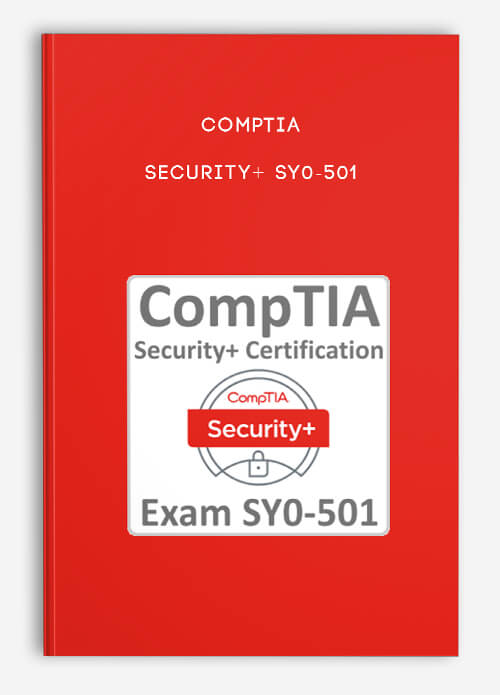CompTIA Security+ SY0-501
$299.00 $62.00
Product Include:
File size:
CompTIA Security+ SY0-501
**More information:
Get CompTIA Security+ SY0-501 at Salaedu.com
Description
The CompTIA Security+ covers the latest SY0-501 version of the CompTIA Security+ certification exam. The course enables the students to gain the basic knowledge needed to plan, implement, and maintain information security in a vendor-neutral format. The course includes topics such as risk management, host and network security, authentication and access control systems, cryptography, and organizational security. The course contents are based on the CompTIA Security+ (SY0-501) certification exam and completely covers all the exam topics through theoretical and scenario-based learning examples.
The CompTIA Security+ is the premier vendor-neutral security certification. This preparatory course for the CompTIA Security+ certification exam assures that the students completely learn and understand the exam topics of the latest SY0-501 exam version. The students will be able to demonstrate their knowledge of security concepts, tools, and procedures. It also confirms their ability to react to security incidents, and validates their skills in anticipating security risks and guarding against them.
We guarantee that all our online courses will meet or exceed your expectations. If you are not 100% satisfied with a course – for any reason at all – simply request a full refund.
That’s our promise to you. We hate games, gimmicks and tricks as much as you do. We guarantee no hassles if you want a refund, so ahead and order with confidence. You have absolutely nothing to lose.
Course Curriculum
Course Introduction
StartCourse Introduction (1:55)
StartCourseware Information (0:15)
StartInstructor Introduction (1:33)
Chapter 01 – Identifying Security Fundamentals
StartIdentifying Security Fundamentals (1:11)
StartTopic A: Identify Information Security Concepts (0:53)
StartInformation Security (1:18)
StartGoals of Information Security (1:56)
StartRisk (3:08)
StartVulnerabilities (2:06)
StartThreats (0:58)
StartAttacks (1:16)
StartControls (1:31)
StartTypes of Controls (1:27)
StartThe Security Management Process (1:45)
StartDemo – Identifying Information Security Basics (2:41)
StartTopic B: Identify Basic Security Controls (0:37)
StartThe CIA Triad (0:28)
StartThe CIA Triad (cont.) (5:09)
StartNon-repudiation (0:43)
StartIdentification (1:05)
StartAuthentication (0:47)
StartAuthentication Factors (4:01)
StartAuthorization (0:58)
StartAccess Control (0:46)
StartAccounting and Auditing (1:02)
StartPrinciple of Least Privilege (1:58)
StartPrivilege Management (3:02)
StartDemo – Identifying Basic Security Controls (1:58)
StartTopic C: Identify Basic Authentication and Authorization Concepts (0:49)
StartPasswords (2:04)
StartTokens (1:27)
StartBiometrics (1:53)
StartGeolocation (1:26)
StartKeystroke Authentication (1:18)
StartMulti-factor Authentication (1:36)
StartMutual Authentication (0:36)
StartDemo – Identifying Basic Authentication and Authorization Concepts (2:31)
StartTopic D: Identify Basic Cryptography Concepts (0:37)
StartCryptography (1:34)
StartEncryption and Decryption (1:56)
StartEncryption and Decryption (cont.) (0:53)
StartEncryption and Security Goals (1:34)
StartCiphers (1:20)
StartA Key (2:11)
StartSymmetric Encryption (0:55)
StartAsymmetric Encryption (1:45)
StartAsymmetric Encryption ( cont.) (1:56)
StartHashing (1:54)
StartSteganography (1:46)
StartDemo – Identifying Basic Cryptography Concepts (4:43)
StartChapter 01 Review (0:55)
StartReview Questions
Chapter 02 – Analyzing Risk
StartAnalyzing Risk (1:06)
StartTopic A: Analyze Organizational Risk (0:37)
StartRisk Management (1:10)
StartComponents of Risk Analysis (2:17)
StartPhases of Risk Analysis (2:41)
StartCategories of Threat Types (1:38)
StartRisk Analysis Methods (1:36)
StartRisk Calculation (3:10)
StartRisk Response Techniques (2:08)
StartRisk Mitigation and Control Types (2:20)
StartChange Management (2:00)
StartChange Management (cont.) (1:15)
StartGuidelines for Analyzing Risk (1:15)
StartDemo – Analyzing Risks to the Organization (3:03)
StartTopic B: Analyze the Business Impact of Risk (0:42)
StartBIA (1:14)
StartImpact Scenarios (1:17)
StartImpact Scenarios (cont.1) (0:40)
StartImpact Scenarios (cont.2) (1:43)
StartPrivacy Assessments (2:06)
StartCritical Systems and Functions (1:04)
StartMaximum Tolerable Downtime (0:54)
StartRecovery Point Objective (1:01)
StartRecovery Time Objective (0:38)
StartMean Time to Failure (0:34)
StartMean Time to Repair (0:39)
StartMean Time Between Failures (1:03)
StartGuidelines for Performing a Business Impact Analysis (0:55)
StartDemo – Performing a Business Impact Analysis (3:49)
StartChapter 02 Review (0:51)
StartReview Questions
Chapter 03 – Identifying Security Threats
StartIdentifying Security Threats (1:44)
StartTopic A: Identify Types of Attackers (0:29)
StartHackers and Attackers (2:42)
StartHackers and Attackers (cont.) (2:00)
StartThreat Actors (2:12)
StartThreat actors (cont.) (0:21)
StartThreat Actor Attributes (2:35)
StartThreat Actor Attributes (cont.) (1:18)
StartOpen-Source Intelligence (1:35)
StartDemo – Identifying Types of Attackers (2:46)
StartTopic B: Identify Social Engineering Attacks (1:27)
StartSocial Engineering (1:46)
StartSocial Engineering (cont.) (1:56)
StartEffectiveness (5:49)
StartImpersonation (1:47)
StartPhishing and Related Attacks (4:12)
StartPhishing and Related Attacks (cont.) (2:40)
StartHoaxes (1:14)
StartPhysical Exploits (1:57)
StartWatering Hole Attacks (0:58)
StartDemo – Identifying Social Engineering Attacks (2:09)
StartTopic C: Identify Malware (0:30)
StartMalicious Code (0:53)
StartMalicious Code (cont.) (1:07)
StartViruses (1:58)
StartWorms (0:59)
StartAdware (0:42)
StartSpyware (1:08)
StartTrojan Horses (1:02)
StartKeyloggers (1:22)
StartRemote Access Trojans (0:37)
StartLogic Bombs (1:20)
StartBotnets (2:28)
StartBonets (cont.) (0:19)
StartRansomware (3:19)
StartRansomware (cont.) (0:56)
StartAdvance Persistent Threats (1:04)
StartDemo – Identifying Types of Malware (2:44)
StartTopic D: Identify Software-Based Threats (0:37)
StartSoftware Attacks (0:45)
StartPassword Attacks (0:52)
StartTypes of Password Attacks (2:20)
StartTypes of Password Attacks (cont.) (2:13)
StartCryptographic Attacks (0:48)
StartTypes of Cryptographic Attacks (2:36)
StartTypes of Cryptographic Attacks (cont.) (1:21)
StartBackdoor Attacks (1:15)
StartBackdoor Attaxks (cont.) (0:18)
StartApplication Attacks (1:08)
StartApplication Attacks (cont.) (0:28)
StartTypes of Application Attacks (4:29)
StartDriver Manipulation (1:23)
StartPrivilege Escalation (1:21)
StartPrivilege Escalation (cont.) (0:20)
StartDemo – Identifying Password Attacks (7:51)
StartTopic E: Identify Network-Based Threats (1:04)
StartTCP/IP Basics (3:06)
StartTCP/IP (cont.) (3:50)
StartSpoofing Attacks (0:52)
StartIP and MAC Address Spoofing (1:10)
StartIP and MAC Address Spoofing (cont.) (0:47)
StartARP Poisoning (2:33)
StartDNS Poisoning (1:57)
StartPort Scanning Attacks (2:09)
StartPort Scanning Attacks (cont.) (0:13)
StartScan Types (1:13)
StartScan Types (cont.) (0:54)
StartEavesdropping Attacks (1:21)
StartMan-in-the-Middle Attacks (0:44)
StartMan-in-the-Middle Attacks (cont.) (0:37)
StartMan-in-the-Browser Attacks (1:00)
StartReplay Attacks (0:37)
StartReplay Attacks (cont.) (0:34)
StartDoS Attacks (1:39)
StartDDoS Attacks (1:22)
StartHijacking Attacks (1:24)
StartHijacking Attacks (cont.) (1:29)
StartAmplification Attacks (0:35)
StartAmplification Attacks (cont.) (1:57)
StartPass the Hash Attacks (1:08)
StartDemo – Identifying Threats to DNS (4:01)
StartDemo – Identifying Port Scanning Threats (7:26)
StartTopic F: Identify Wireless Threats (0:40)
StartRogue Access Points (0:51)
StartEvil Twins (1:03)
StartJamming (0:36)
StartBluejacking (1:27)
StartBluesnarfing (0:57)
StartNear Field Communication Attacks (1:03)
StartRFID System Attacks (0:58)
StartWar Driving, War Walking, and War Chalking (1:11)
StartPacket Sniffing (0:44)
StartIV Attacks (1:16)
StartWireless Replay Attacks (0:23)
StartWEP and WPA Attacks (2:38)
StartWPS Attacks (1:04)
StartWireless Disassociation (0:57)
StartDemo – Identifying Wireless Threats (3:02)
StartTopic G: Identify Physical Threats (0:55)
StartPhysical Threats and Vulnerabilities (0:50)
StartHardware Attacks (0:44)
StartEnvironmental Threats and Vulnerabilities (2:01)
StartEnvironmental Threats and Vulnerabilities (cont.) (1:06)
StartDemo – Identifying Physical Threats (1:58)
StartChapter 03 Review (1:16)
StartReview Questions
Chapter 04 – Conducting Security Assessments
StartConducting Security Assessments (0:53)
StartTopic A: Identify Vulnerabilities (0:26)
StartHost Vulnerabilities (3:17)
StartSoftware Vulnerabilities (4:04)
StartEncryption Vulnerabilities (1:59)
StartNetwork Architecture Vulnerabilities (2:05)
StartAccount Vulnerabilities (1:23)
StartOperations Vulnerabilities (3:06)
StartDemo – Identifying Vulnerabilities (2:57)
StartTopic B: Assess Vulnerabilities (0:24)
StartSecurity Assessment (1:56)
StartSecurity Assessment Techniques (2:43)
StartVulnerability Assessment Tools (3:16)
StartTypes of Vulnerability Scans (1:45)
StartFalse Positives (2:25)
StartGuidelines for Assessing Vulnerabilities (2:27)
StartDemo – Capturing Network Data with Wireshark (8:25)
StartDemo – Scanning for General Vulnerabilities (5:20)
StartTopic C: Implement Penetration Testing (0:28)
StartPenetration Testing (1:07)
StartPenetration Testing Techniques (3:05)
StartBox Testing Methods (1:28)
StartPenetration Testing Tools (0:58)
StartGuidelines for Implementing Penetration Testing (0:59)
StartDemo – Implementing Penetration Testing (4:50)
StartChapter 04 Review (0:55)
StartReview Questions
Chapter 05 – Implementing Host and Software Security
StartImplementing Host and Software Security (1:04)
StartTopic A: Implement Host Security (0:23)
StartHardening (1:58)
StartOperating System Security (1:41)
StartOperating System Hardening Techniques (1:34)
StartTrusted Computing Base (1:37)
StartHardware and Firmware Security (2:01)
StartHardware and Firmware Security (cont.) (1:18)
StartSecurity Baselines (0:57)
StartSoftware Updates (2:44)
StartApplication Blacklisting and Whitelisting (1:32)
StartLogging (1:07)
StartAuditing (1:57)
StartAnti-malware Software (1:49)
StartTypes of Anti-malware Software (2:42)
StartHardware Peripheral Security (3:30)
StartEmbedded Systems (1:29)
StartSecurity Implications for Embedded Systems (2:04)
StartSecurity Implications for Embedded System (cont.) (2:10)
StartGuidelines for Securing Hosts (1:47)
StartDemo – Implementing Auditing (4:41)
StartDemo – Hardening a Server (6:01)
StartTopic B: Implement Cloud and Virtualization Security (0:28)
StartVirtualization (2:50)
StartHypervisors (1:35)
StartHypervisors (cont.) (1:42)
StartVirtual Desktop Infrastructure (0:56)
StartVirtualization Security (2:42)
StartCloud Computing (2:46)
StartCloud Deployment Models (3:56)
StartCloud Service Types (3:41)
StartGuidelines for Securing Virtualized and Cloud-Based Resources (1:22)
StartDemo – Securing Virtual Machine Networking (2:14)
StartTopic C: Implement Mobile Device Security (0:38)
StartMobile Device Connection Methods (2:15)
StartMobile Device Connection Methods (cont.) (1:52)
StartMobile Device Management (0:42)
StartMobile Device Security Controls (2:42)
StartMobile Device Security Controls (cont.) (2:18)
StartMobile Device Monitoring and Enforcement (3:08)
StartMobile Device Monitoring and Enforcement (cont.) (2:44)
StartMobile Deployment Models (3:10)
StartBYOD Security Controls (2:46)
StartGuidelines for Implementing Mobile Device Security (1:39)
StartDemo – Implementing Mobile Device Security (2:10)
StartTopic D: Incorporate Security in the Software Development Lifecycle (0:32)
StartSoftware Development Lifecycle (0:55)
StartSoftware Development Models (2:48)
StartDevOps (1:36)
StartVersioning (1:16)
StartSecure Coding Techniques (3:01)
StartSecure Coding Techniques (cont.) (1:42)
StartCode Testing Methods (1:35)
StartGuidelines for Incorporating Security in the Software Development Lifecycle (0:57)
StartDemo – Performing Static Code Analysis (4:30)
StartChapter 05 Review (0:35)
StartReview Questions
Chapter 06 – Implementing Network Security
StartMobile Device Monitoring and Enforcement (0:47)
StartTopic A: Configure Network Security Technologies (0:40)
StartNetwork Components (1:24)
StartNetwork Devices (0:29)
StartRouters (2:00)
StartSwitches (2:42)
StartProxies (2:28)
StartFirewalls (3:04)
StartLoad Balancer (2:29)
StartNetwork Scanners and Analysis Tools (1:05)
StartIntrusion Detection Systems (0:45)
StartNetwork IDS (1:47)
StartIntrusion Prevention Systems (1:19)
StartNetwork IPS (0:47)
StartTypes of Network Monitoring Systems (1:45)
StartSecurity Information and Event Management (1:08)
StartData Loss/Leak Prevention (1:34)
StartVirtual Private Networks (1:14)
StartVPN Concentrators (1:06)
StartSecurity Gateways (1:16)
StartUnified Threat Management (1:18)
StartGuidelines for Configuring Network Security Technologies (1:56)
StartDemo – Configuring a Network IDS (7:53)
StartTopic B: Secure Network Design Elements (0:20)
StartNetwork Access Control (1:57)
StartDemilitarized Zones (0:59)
StartNetwork Isolation (1:46)
StartNetwork Isolation (cont.) (0:18)
StartVirtual Local Area Networks (1:12)
StartVirtual Local Area Networks (cont.) (0:28)
StartNetwork Security Device Placement (2:29)
StartNetwork Address Translation (1:09)
StartSoftware-Defined Networking (0:48)
StartGuidelines for Securing Network Design Elements (1:20)
StartDemo – Securing Network Design Elements (3:32)
StartTopic C: Implement Secure Networking Protocols and Services (0:26)
StartThe Open Systems Interconnection Model (3:45)
StartOSI Model and Security (0:45)
StartInternet Protocol Suite (4:01)
StartDomain Name System (2:34)
StartHypertext Transfer Protocol (0:55)
StartSecure Sockets Layer/Transport Layer Security (1:51)
StartSecure Sockets Layer/Transport Layer Security (cont.) (1:09)
StartHTTP Secure (0:28)
StartSecure Shell (0:58)
StartSimple Network Management Protocol (1:10)
StartReal-Time Transport Protocol (1:13)
StartInternet Control Message Protocol (1:23)
StartInternet Protocol Security (3:27)
StartNetwork Basic Input/Output System (1:05)
StartFile Transfer Protocols (1:57)
StartEmail Protocols (2:48)
StartAdditional Networking Protocols and Services (1:36)
StartPorts and Port Ranges (1:37)
StartDemo – Installing an Internet Information Services Web Server with Basic Security (10:36)
StartDemo – Securing Network Traffic Using IPSec (6:00)
StartTopic D: Secure Wireless Traffic (0:18)
StartWireless Networks (1:32)
StartWireless Antenna Types (2:32)
Start802.11 Protocols (3:04)
StartWireless Cryptographic Protocols (2:17)
StartWireless Authentication Protocols (2:34)
StartVPNs and Open Wireless (1:16)
StartWireless Client Authentication Methods (1:46)
StartWireless Access Point Security (2:05)
StartCaptive Portals (0:42)
StartSite Surveys (0:52)
StartGuidelines for Securing Wireless Traffic (1:29)
StartDemo – Securing Wireless Traffic (6:12)
StartChapter 06 Review (0:33)
StartReview Questions
Chapter 07 – Managing Identity and Access
StartManaging Identify and Access (0:58)
StartTopic A: Implement Identity and Access Management (0:26)
StartIdentity and Access Management (2:10)
StartAccess Control Models (4:47)
StartPhysical Access Control Devices (1:08)
StartBiometric Devices (3:26)
StartCertificate-Based Authentication (1:45)
StartFile System and Database Access (2:11)
StartGuidelines for Implementing IAM (1:29)
StartDemo – Implementing DAC for a File Share (6:17)
StartTopic B: Configure Directory Services (0:19)
StartDirectory Services (1:16)
StartDirectory Services (cont.) (0:44)
StartLightweight Directory Access Protocol (1:48)
StartSecure LDAP (0:44)
StartCommon Directory Services (2:17)
StartDemo – Backing Up Active Directory (8:15)
StartTopic C: Configure Access Services (0:24)
StartRemote Access Methods (1:19)
StartTunneling (1:21)
StartRemote Access Protocols (2:09)
StartHMAC-Based One-Time Password (1:26)
StartTime-Based OTP (0:42)
StartPassword Authentication Protocol (0:43)
StartChallenge-Handshake Authentication Protocol (2:34)
StartNT LAN Manager (1:19)
StartAuthentication, Authorization, and Accounting (0:51)
StartRemote Authentication Dial-In User Service (0:55)
StartRemote Authentication Dial-In User Service (cont.) (1:00)
StartTerminal Access Controller Access-Control System (1:04)
StartKerberos (1:19)
StartKerberos (Cont.) (2:54)
StartDemo – Configuring a Remote Access Server (6:06)
StartDemo – Setting Up Remote Access Authentication (4:17)
StartTopic D: Manage Accounts (0:20)
StartAccount Management (0:44)
StartAccount Privileges (2:07)
StartAccount Types (2:42)
StartAccount Policy (1:55)
StartPassword Policy (3:06)
StartMultiple Accounts (1:15)
StartShared Accounts (1:43)
StartAccount Management Security Controls (3:29)
StartCredential Management (1:05)
StartGroup Policy (1:03)
StartIdentity Federation (2:40)
StartIdentity Federation Methods (2:07)
StartGuidelines for Managing Accounts (1:14)
StartDemo – Managing Accounts (5:13)
StartChapter 07 Review (0:30)
StartReview Questions
Chapter 08 – Implementing Cryptography
StartImplementing Crytography (0:52)
StartTopic A: Identify Advanced Cryptography Concepts (0:21)
StartCryptography Elements (3:01)
StartHashing Concepts (1:33)
StartData States (1:51)
StartKey Exchange (1:30)
StartKey Exchange (cont.) (0:17)
StartDigital Signatures (0:49)
StartDigital Signatures (cont.) (0:40)
StartCipher Suites (1:35)
StartSession Keys (1:16)
StartKey Stretching (0:43)
StartSpecial Considerations for Cryptography (2:20)
StartDemo – Identifying Advanced Cryptographic Concepts (2:55)
StartTopic B: Select Cryptographic Algorithms (0:14)
StartTypes of Ciphers (1:43)
StartTypes of Hashing Algorithms (1:36)
StartTypes of Symmetric Encryption Algorithms (2:25)
StartTypes of Asymmetric Encryption Techniques (2:09)
StartTypes of Key Stretching Algorithms (0:54)
StartSubstitution Ciphers (1:14)
StartExclusive Or (1:24)
StartCryptographic Modules (1:14)
StartDemo – Selecting Cryptographic Algorithms (2:22)
StartTopic C: Configure a Public Key Infrastructure (0:32)
StartPublic Key Infrastructure (0:59)
StartPKI Components (2:54)
StartCA Hierarchies (2:39)
StartThe Root CA (0:39)
StartSubordinate CAs (0:44)
StartOffline Root CAs (0:43)
StartTypes of Certificates (2:23)
StartTypes of Certificates (cont.) (2:41)
StartX.509 (0:56)
StartCertificate File Formats (2:00)
StartCA Hierarchy Design Options (2:08)
StartDemo – Installing a CA (5:30)
StartDemo – Securing a Windows Server 2016 CA (7:39)
StartTopic D: Enroll Certificates (0:26)
StartThe Certificate Enrollment Process (1:23)
StartThe Certificate Lifecycle (1:22)
StartCertificate Lifecycle Management (1:46)
StartThe SSL/TLS Connection Process (1:02)
StartDemo – Enrolling Certificates (4:32)
StartDemo – Securing Network Traffic with Certificates (2:26)
StartTopic E: Back Up and Restore Certificates and Private Keys (0:28)
StartPrivate Key Protection Methods (1:12)
StartKey Escrow (2:20)
StartPrivate Key Restoration Methods (2:01)
StartPrivate Key Replacement (0:38)
StartDemo – Backing Up a Certificate and Private Key (3:28)
StartDemo – Restoring a Certificate and Private Key (1:16)
StartTopic F: Revoke Certificates (0:17)
StartCertificate Revocation (1:04)
StartCertificate Revocation List (1:40)
StartCertificate Revocation List (cont.) (0:22)
StartOnline Certificate Status Protocol (1:38)
StartDemo – Revoking Certificates (2:36)
StartChapter 08 Review (1:03)
StartReview Questions
Chapter 09 – Implementing Operational Security
StartImplementing Operational Security (0:41)
StartTopic A: Evaluate Security Frameworks and Guidelines (0:21)
StartSecurity Frameworks (1:27)
StartSecurity Framework Examples (1:37)
StartSecurity Configuration Guides (1:37)
StartCompliance (1:30)
StartLayered Security (1:07)
StartDefense in Depth (0:46)
StartDemo – Evaluating Security Frameworks and Guidelines (2:53)
StartTopic B: Incorporate Documentation in Operational Security (0:19)
StartSecurity Policies (1:11)
StartSecurity Policies (cont.) (0:43)
StartCommon Security Policy Types (2:57)
StartPersonnel Management (0:51)
StartSeparation of Duties (0:53)
StartJob Rotation (1:17)
StartMandatory Vacation (0:54)
StartAdditional Personnel Management Tasks (1:35)
StartTraining and Awareness (2:01)
StartBusiness Agreements (1:43)
StartGuidelines for Incorporating Documentation in Operational Security (1:08)
StartDemo – Incorporating Documentation in Operational Security (3:48)
StartTopic C: Implement Security Strategies (0:26)
StartSecurity Automation (1:42)
StartScalability (1:03)
StartElasticity (1:17)
StartRedundancy (1:15)
StartFault Tolerance (0:50)
StartRedundant Array of Independent Disks (1:33)
StartNon-persistence (1:27)
StartHigh Availability (1:08)
StartDeployment Environments (1:44)
StartGuidelines for Implementing Security Strategies (1:15)
StartDemo – Implementing Virtual Machine Snapshots (2:37)
StartTopic D: Manage Data Security Processes (0:24)
StartData Security (0:53)
StartData Security Vulnerabilities (0:51)
StartData Storage Methods (1:14)
StartData Encryption Methods (1:04)
StartData Sensitivity (1:32)
StartData Management Roles (1:28)
StartData Retention (1:00)
StartData Disposal (2:18)
StartGuidelines for Managing Data Security (0:54)
StartDemo – Destroying Data Securely (6:36)
StartDemo – Encrypting a Storage Device (3:48)
StartTopic E: Implement Physical Controls (0:26)
StartPhysical Security Controls (1:20)
StartPhysical Security Control Types (1:56)
StartPhysical Security Controls Types (cont. Part 1) (1:38)
StartPhysical Security Controls Types (cont. Part 2) (1:23)
StartPhysical Security Controls Types (cont. Part 3) (0:46)
StartEnvironmental Exposures (0:36)
StartEnvironmental Controls (1:19)
StartEnvironmental Controls (cont.) (1:14)
StartEnvironmental Monitoring (0:37)
StartSafety (0:45)
StartGuidelines for Implementing Physical Controls (0:53)
StartDemo – Implementing Physical Controls (1:41)
StartChapter 09 Review (0:31)
StartReview Questions
Chapter 10 – Addressing Security Issues
StartAddressing Security Issues (0:59)
StartTopic A: Troubleshoot Common Security Issues (0:24)
StartAccess Control Issues (1:54)
StartEncryption Issues (1:21)
StartData Exfiltration (1:08)
StartAnomalies in Event Logs (1:21)
StartSecurity Configuration Issues (2:11)
StartBaseline Deviations (1:14)
StartSoftware Issues (1:10)
StartPersonnel Issues (1:53)
StartAsset Management Issues (1:06)
StartDemo – Identifying Event Log Anomalies (3:41)
StartTopic B: Respond to Security Incidents (0:14)
StartIncident Response (0:51)
StartIncident Preparation (1:00)
StartIncident Detection and Analysis (0:57)
StartIncident Containment (0:49)
StartIncident Eradication (0:32)
StartIncident Recovery (1:01)
StartLessons Learned (0:43)
StartIncident Response Plans (1:31)
StartFirst Responders (0:31)
StartAn Incident Report (0:42)
StartGuidelines for Responding to Security Incidents (0:33)
StartDemo – Responding to a Security Incident (2:39)
StartTopic C: Investigate Security Incidents (0:17)
StartComputer Forensics (0:42)
StartThe Basic Forensic Process (1:34)
StartPreservation of Forensic Data (1:34)
StartBasic Forensic Response Procedures (1:29)
StartBasic Forensic Response Procedure (cont.) (1:03)
StartOrder of Volatility (0:34)
StartChain of Custody (0:24)
StartGuidelines for Investigating Security Incidents (0:53)
StartDemo – Implementing Forensic Procedures (5:39)
StartChapter 10 Review (0:33)
StartReview Questions
Chapter 11 – Ensuring Business Continuity
StartEnsuring Business Continuity (0:43)
StartTopic A: Select Business Continuity and Disaster Recovery Processes (0:22)
StartBusiness Continuity and Disaster Recovery (1:55)
StartThe Disaster Recovery Process (1:50)
StartRecovery Team (0:40)
StartOrder of Restoration (1:46)
StartRecovery Sites (1:13)
StartSecure Recovery (0:34)
StartBackup Types (Full) (0:44)
StartBackup Types (Differential vs. Incremental) (1:37)
StartSecure Backups (1:21)
StartGeographic Considerations (1:27)
StartGuidelines for Selecting Business Continuity and Disaster Recovery Processes (1:28)
StartDemo – Selecting Business Continuity and Disaster Recovery Processes (2:14)
StartTopic B: Develop a Business Continuity Plan (0:16)
StartBusiness Continuity Plans (1:15)
StartBusiness Continuity Plans (cont.) (0:17)
StartDisaster Recovery Plans (1:00)
StartDisaster Recovery Plans (cont.) (0:25)
StartIT Contingency Plans (0:50)
StartSuccession Plans (0:23)
StartFailover (1:08)
StartAlternate Business Practices (0:42)
StartTesting Exercises (1:05)
StartAfter-Action Reports (1:06)
StartGuidelines for Developing a BCP (0:58)
StartDemo – Developing a BCP (1:58)
StartChapter 11 Review (0:26)
StartReview Questions
StartCourse Closure (2:24)
Forex Trading – Foreign Exchange Course
Want to learn about Forex?
Foreign exchange, or forex, is the conversion of one country’s currency into another.
In a free economy, a country’s currency is valued according to the laws of supply and demand.
In other words, a currency’s value can be pegged to another country’s currency, such as the U.S. dollar, or even to a basket of currencies.
A country’s currency value may also be set by the country’s government.
However, most countries float their currencies freely against those of other countries, which keeps them in constant fluctuation.
1 review for CompTIA Security+ SY0-501
Add a review Cancel reply
Related products
Forex - Trading & Investment
Paul Lemal – Bottom Springers. Bonsai Elite WaveTrader Course (8 DVDs & Manuals)
Forex - Trading & Investment
Forex - Trading & Investment
Mike McMahon – Professional Trader Series DVD Set (Full) (tradingacademy.com)











king –
We encourage you to check Content Proof carefully before paying.“Excepted” these contents: “Online coaching, Software, Facebook group, Skype and Email support from Author.”If you have enough money and feel good. We encourage you to buy this product from the original Author to get full other “Excepted” contents from them.Thank you!